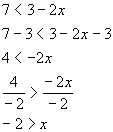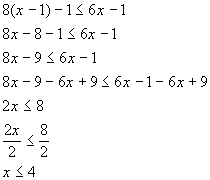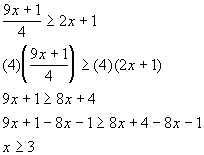


Interval notation: (-![]() ,
-2)
,
-2)
Graph:

*Inv. of mult. by -2 is div. both sides by
-2, so reverse inequality sign
*Open interval indicating all values less than -3
*Visual showing all numbers less than -2 on the number line
Interval notation:
We have an open interval since there we are not including where it
is equal to -2. x is less than
-2, so -2 is our largest value of the interval so it goes on the right.
Since there is no lower endpoint (it is ALL values less than -2), we put
the negative infinity symbol on the left side. The curved end on
-2 indicates an open interval. Negative infinity always has a curved
end because there is not an endpoint on that side.
Graph:
We use the same type of notation on the endpoint as we did in the interval
notation, a curved end. Since we needed to indicate all values
less than -2, the part of the number line that was to the left of -2 was
darkened.

Interval notation: (-![]() ,
4]
,
4]
Graph:

*Get x terms on one side, constants on the other side
*Inv. of mult. by 2 is div. both sides by 2
*Closed interval indicating all values less
than or equal to 4
*Visual showing all numbers less than or equal
to 4 on the number line
Graph:
Again, we use the same type of notation on the endpoint as we did in
the interval notation - a boxed end. Since we needed to indicate
all values less than or equal to 4, the part of the number line that was
to the left of 4 was darkened.

Interval notation: [3, ![]() )
)
Graph:

*Mult. both sides by the LCD
*Get x terms on
one side, constants on the other
*Closed interval indicating all values greater
than or equal to 3
*Visual showing all numbers greater than or equal to 3 on the number line
Graph:
Again, we use the same type of notation on the endpoint as we did in
the interval notation - a boxed end. Since we needed to indicate
all values greater than or equal to 3, the part of the number line that
was to the right of 3 was darkened.
Last revised on July 3, 2011 by Kim Seward.
All contents copyright (C) 2001 - 2011, WTAMU and Kim Seward.
All rights reserved.